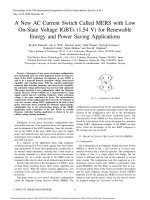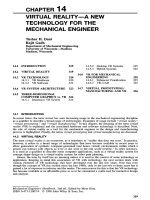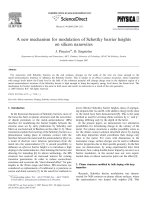- Trang chủ >>
- Khoa Học Tự Nhiên >>
- Vật lý
A new mechanism for modulation of schottky barrier heights on silicon nanowires
Bạn đang xem bản rút gọn của tài liệu. Xem và tải ngay bản đầy đủ của tài liệu tại đây (747.07 KB, 5 trang )
Physica E 40 (2008) 2508–2512
A new mechanism for modulation of Schottky barrier heights
on silicon nanowires
J. Piscator
Ã
, O. Engstro
¨
m
Department of Microtechnology and Nanoscience, MC2, Chalmers University of Technology, SE-412 96 Go
¨
teborg, Sweden
Available online 10 August 2007
Abstract
For nanowires with Schottky barriers on the end surfaces, charges on the walls of the wire are close enough to the
metal–semiconductor interface to influence the Schottky barrier. This is similar to an effect in planar structures, where impurities
with energy levels below the Fermi level in the bulk of the substrate material will change charge state in the depletion region of a
metal–semiconductor structure if the Schottky barrier is high enough to bring the impurity energy level above the Fermi level. The
mechanism for barrier modulation is the same in both cases and occurs in nanowires as a result of the wire geometry.
r 2007 Elsevier B.V. All rights reserved.
PACS: 81.07.Lk, 61.72.Ày, 73.30.+y
Keywords: Silicon nanowires; Doping; Schottky contact; Oxide charge
1. Introduction
In the historical discussion of Schottky barriers, most of
the focus has been on planar structures and the occurrence
of dipole potentials at the metal–semiconductor (MS)
interface for modulating the barrier heights between the
extreme cases set by early predictions by Sch ottky and
Mott on one hand and of Bardeen on the other [1–3]. These
treatments explain the lowering of the Schottky barrier as a
phenomenon taking place in intimate contact with the
interface between the metal and the semiconductor [4] or as
a result of electron wave function penetration from the
metal into the semiconductor [5]. A second possibility to
influence an effective barrier height is to introduce a high
doping in the semiconductor, thus thinning the barrier and
allowing for tunneling [6]. In silicon technology, the MS
structure has received an increased interest for coming
transistor generations. In order to reduce source/drain
resistance and overcome the ‘‘short channel effect’’ for gate
lengths in the 20 nm range and below, MS structures are
considered as replacements of traditional p–n junctions as
source and drain contacts [7]. In the search for methods to
lower effe ctive Schottky barrier heights, ideas of segregat-
ing dopants like As and B, with shallow energy levels close
to the metal have been demonstrated [8]. This is the same
method as used for creating ohmic contacts by n
+
and p
+
doping, differing only by the depth of the latter.
In the present paper, we demonstrate two alternative
possibilities for introducing charge in the vicinity of the
metal. For planar structures a similar possibility exists as
for the ohmic contact solution described above by doping
with deep impurities which contributes their charge only
close to the metal. For wires with dimensions in the
nanometer range, surface charges can be used to influence
barrier properties due to their specific geometry. In the first
case, we demonstrate, by using experimental data from
literature, how a deep double donor impurity can serve as a
barrier modulator, in the second case our own experi-
mental data on silicon nanowires point out the effect [9].
2. Planar structures modified by bulk doping with deep
impurities
Recently, Schottky barrier modulation was demon-
strated for NiSi contacts on planar silicon surfaces, where
the semiconductor was doped with sulphur [10]. This
ARTICLE IN P RESS
www.elsevier.com/locate/physe
1386-9477/$ - see front matter r 2007 Elsevier B.V. All rights reserved.
doi:10.1016/j.physe.2007.07.018
Ã
Corresponding author. Tel.: +46 31 7721862; fax: +46 31 7723622.
E-mail address: (J. Piscator).
element creates a double donor in silicon with a ground
state for the first capture d electron at an energy of about
0.55 eV from the conduction band edge. Subsequently, the
second electron is captured into an energy level at about
0.30 eV [11]. Considering a shallow phosphorus doping of
about 10
15
cm
À3
as used in the experiment of Ref. [10], this
corresponds to a Fermi level position at 0.28 eV from the
conduction band. Therefore, in the bulk of an n-type
semiconductor, the sulphur levels are only slightly ionized
at room temperature and the resistivity of the sample is
mainly unchanged. However, the NiSi metal contact has a
barrier height of about 0.65 eV on n-type silicon, which
means that the upper sulphur level passes the Fermi level in
the depletion region, emits the captured electron and
becomes positively charged as demo nstrated by the band
diagram in Fig. 1. Close to the MS interface a small
contribution from the doubly charged energy level at
0.55 eV may occur. Depending on the profile of the sulphur
concentration close to the MS interface, the charge may
give rise to a very thin energy barrier, thus enabling
tunneling at the barrier tip and a lowering of the effective
Schottky barrier height.
Assuming a sulphur dopant distribution with two
exponential tails as obtained from ion implantation and
segregation close to the NiSi/Si interface as shown in
Ref. [10], the charge occurring in the depletion region can
be expressed as
Q ¼ qN
01
exp À
x
x
01
þ qN
02
exp À
x
x
02
þ qN
D
x, (1)
where q is the electron charge, x is the length coordinate
into the semiconductor volume perpendicular to and with
origin at the MS interface, N
01
and N
02
are the surface
concentrations of the two sulphur profiles, x
01
and x
02
are
their decay lengths and N
D
is the shallow doping
concentration in the semiconductor bulk. Using Eq. (1)
in Poisson’s equation, and the materials parameters from
Ref. [10] as mentioned in Fig. 2, the shape of the
conduction band is demonstrated with and without sulphur
doping. One notices a considerable decrease of the barrier
width, facilitating tunneling of electrons and a decreasing
effective Schottky barrier height. Fig. 3 demonstrates the
barrier height at 1 nm from the MS interface as a function
of the sulphur surface concentration taking this depth as a
reasonable value for substantial tunneling. This gives an
energy lowering similar to the experimental data as given in
Ref. [10].
3. Schottky barriers at nanowire end surfaces modified by
surface charge
For nanowire widths in the 10 nm range, surface charges
may exist close enough to the MS interface to influence the
shape of the Schottky barrier. The result of a theoretical
calculation for the barrier lowering of a wire with
10 Â 10 nm
2
cross section is shown in Fig. 4. Positive
ARTICLE IN P RESS
Fig. 1. Band diagram of a NiSi–Si contact at zero bias showing the two
energy levels of a sulphur double donor and the Fermi level for a doping
concentration of 8 Â 10
14
cm
À3
.
0 1×10
−6
2×10
−6
3×10
−6
4×10
−6
5×10
−6
6×10
−6
x[cm]
0.1
0.2
0.3
0.4
0.5
0.6
E
C
[eV]
b
a
Fig. 2. Conduction band edge as a function of depth at thermal
equilibrium (a) with and (b) without sulphur doping. Parameter values
for the sulphur profile were taken from Ref. [10] as: N
01
¼ 5 Â 10
18
cm
À3
,
N
02
¼ 5 Â 10
17
cm
À3
, x
01
¼ 10nm, and x
02
¼ 30nm (see Eq. (1)). The
shallow donor doping of the semiconductor is N
D
¼ 8 Â 10
14
cm
À3
, the
Fermi level is at zero energy and the Schottky barrier height is 0.65 eV.
0 1×10
19
2×10
19
3×10
19
4×10
19
5×10
19
N
01
[cm
−3
]
0
0.1
0.2
0.3
0.4
0.5
0.6
E
C
[eV]
Fig. 3. Conduction band edge at x ¼ 1 nm versus increasing sulphur
concentration, N
01
. N
02
is simultaneously taken as N
02
¼ 0.1 Â N
01
.
J. Piscator, O. Engstro
¨
m / Physica E 40 (2008) 2508–2512 2509
elementary point charges are placed on the surface of the
wire to a concentration of 4 Â 10
12
cm
À2
and mirrored in
the metal. The barrier lowering for this concentration at a
distance of 1 nm from the MS interface, enough for
appreciable carrier tunneling, is seen to be about 0.2 eV.
For our experiments, samples with Pd
2
Si/Si Schottky
contacts on the end surfa ces of silicon wires were prepared
on SOI material by electron beam lithography. By using
the substrate as a back-gate, the potential distribution
along the wire could be chosen to separate electron and
hole injection. The sample configuration, contact geometry
and charge distribution are demonstrated in Fig. 5. The
preparation started from an SOI wafer with a silicon film
thickness of 55 nm and a buried oxide layer (BOX) of
145 nm. After thinning the silicon film to 30 nm and
performing patterning by e-beam lithography and plasma
etching, wires with a 30 Â 30 nm
2
cross section were
created. By oxidation of the wires in dry atmosphere at
800 1C for 90 min, the wires were embedded in a SiO
2
shell
of about 10 nm, with a silicon core of 15–20 nm width.
Following evaporation and patterning of Pd, MS struc-
tures of Pd
2
Si solely in contact with the end surfaces of the
wires were obtained by annealing at 250 1C for 20 min.
Using the Pd
2
Si contacts as source and drain and the
silicon substrate as a back-gate, a transistor configuration
can be defined as shown in Fig. 5(a).
Transfer characteristics at different temperatures for a
constant drain voltage of À5 V are shown in Fig. 6. Three
different regimes can be observed among the graphs. In
regime A, the negative gate voltage pushes the energy
bands of the wire to higher energies, thus thwarting the
injection of electrons from drain. At the source contact, the
electric field is increased for negative gate voltages, which
allows for hole injection. In regime B, the energy bands are
lowered such that hole injection is thwarted and the electric
field at drain is increased. This situation favours injection
of electrons from drain. Finally, in regime C, the injected
electron current has reached values such that the Schottky
diode at source needs to be markedly forward biased in
order to bring about enough carrier transport. This lifts the
ARTICLE IN P RESS
Fig. 4. (a) Schematic 10 Â 10 nm
2
nanowire geometry with a metal contact at the end surface. (b) Conduction band lowering 1 nm from the interface due to
an introduced positive point charge distribution surrounding the wire. The point charges correspond to a surface state density of 4 Â 10
12
cm
À2
.
J. Piscator, O. Engstro
¨
m / Physica E 40 (2008) 2508–25122510
energy bands and allows for ambipolar transport limited
by the two MS structures in combination.
Therefore, from Arrhenius plots of the injection currents
in the three regimes A, B and C, activation energies
corresponding to the electron and hole barriers of the Pd
2
Si
Schottky contacts at source and drain can be determined.
Results from such a treatment of the data in Fig. 6 are
shown by the filled squares in the plot of Fig. 7. The values
in regime A are found in the range of 0.15 eV, while regime
B has a sharp maximum at 0.55 eV and regime C again
decreases the activation energy to about 0.25 eV. All these
values are lower than corresponding energy barriers found
for electrons and holes for planar Pd
2
Si structures. It can
also be seen that there are no sharp transitions from the
ARTICLE IN P RESS
Fig. 5. (a) Transistor device structure on SOI with Pd
2
Si source and drain contacts and a back-gate. (b) Cross section of the nanowire with charge close
the Si SiO
2
interface. (c) SEM image of fabricated structure.
Fig. 6. Transfer characteristics measured at different temperatures from
303 to 363 K at a fixed V
DS
of À5 V. Regions A, B and C correspond to
hole injection, electron injection and a combination of the two,
respectively.
Fig. 7. Effective barrier heights extracted from the temperature depen-
dence of the current in Fig. 6. Regions A, B and C can be identified. After
introduction of positive charge the electron barrier is lower and the hole
barrier is correspondingly higher.
J. Piscator, O. Engstro
¨
m / Physica E 40 (2008) 2508–2512 2511
injection of one carrier type to another, instead the change
is gradual as the gate voltage is swept and the potentials
change correspondingly.
In order to investigate whether oxide charge may
influence barrier heights in accordance with the theoretical
estimate abo ve, positive oxide charge was created in the
SiO
2
shell surrounding the silicon wire. This was done by
irradiating the structure with UV light and verifying the
positive charging from the voltage shift in a capacitance
versus voltage measurement on a M OS structure prepared
on the same sample chip with the insulator being the buried
oxide. The result is shown by the circles in Fig. 7. Now the
activation energies in regime A, mainly influenced by the
hole barrier has increased while the values in regime B
influenced by the electron barrier has decreased. On the
other hand, the data in regime C, influenced by both
barriers are mainly on the same level as before UV
irradiation.
4. Discussion
The introduction of charge by a deep impurity close to
the MS interface of a planar structure decreases the
Schottky barrier in n-type silicon only if the impurity acts
as a donor. Two mechanisms contribute to the effect: (i) the
change of charge state occurring in the depletion region
when the impurity energy level passes the Fermi level and,
indirectly, and (ii) the segregation of impurities close to the
MS interface. For barrier modulation on p-type silicon, a
similar effect would be expected from a deep double
acceptor like for instance Zn with an energy level for the
most shallow captured hole at about 0.3 eV from the
valence band edge [12].
For a planar MS structure, where the semiconductor
doping is low enough not to influence the barrier height,
the sum of the electron and hole barriers is equal to the
semiconductor band gap. In the data of Fig. 7, this sum is
below the 1.17 eV band gap value of silicon which would be
expected from the sum of activation plots [13]. Also the
values for the electron and the hole activation energies,
respectively, are both lower than the values of Schottky
barriers obtained on planar structures for Pd
2
Si/Si MS
junctions [14]. This indicates that tunneling occurs already
before the introduction of positive oxide charge due to the
added electric field at the contacts created by the gate
potential. In addition to this, combined injection of both
electrons and holes can take place and what is measured is
the resulting barrier height. However, it is important to
note that the changes of activation energies go in opposite
direction in the tw o regimes A and B, where hole injection
dominates in first case and electron injection in the latter.
This is expected from the influence of a positive oxide
charge as demonstrated in Fig. 4. Moreover, in regime C,
where both carrier types are injected, the activation energy
is mainly the same because the introduced positive oxide
charge changes the barriers in different directions.
Acknowledgments
This work was financed by the Swedish Foundation for
Strategic Research through the NEMO project and by the
European SiNANO Network of Excellence.
References
[1] W. Mo
¨
nch, Rep. Prog., Phys. 53 (1990) 221.
[2] R.T. Tung, Mater. Sci. Eng. R 35 (2001) 1.
[3] A. Cowley, S.M. Sze, J. Appl. Phys. 36 (1965) 3212.
[4] R.T. Tung, Phys. Rev. B 64 (2001) 205310.
[5] V. Heine, Phys. Rev. 138 (1965) 1696.
[6] J. Knoch, M. Zhang, Q.T. Zhao, St. Lenk, S. Mantl, Appl. Phys.
Lett. 87 (2005) 263505.
[7] M. Ono, M. Koyama, A. Nishiyama, Solid State Electron. 51 (2007)
732.
[8] J. Knoch, M. Zhang, J. Appenzeller, S. Mantl, Appl. Phys. A 87
(2007) 351.
[9] J. Piscator, O. Engstro
¨
m, Appl. Phys. Lett. 90 (2007) 132107.
[10] Q.T. Zhao, U. Breier, E. Rije, St. Lenk, S. Mantl, Appl. Phys. Lett.
86 (2005) 062108.
[11] O. Engstro
¨
m, H.G. Grimmeiss, J. Appl. Phys. 47 (1976) 4090.
[12] J.M. Herman III, C.T. Sah, Phys. Status Solidi A 14 (1972) 405.
[13] H.D. Barber, Solid State Electron. 10 (1969) 1039.
[14] O. Engstro
¨
m, H. Pettersson, B. Sernelius, Phys. Status Solidi A 95
(1986) 691.
ARTICLE IN P RESS
J. Piscator, O. Engstro
¨
m / Physica E 40 (2008) 2508–25122512









